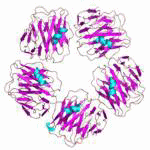Molecular Biology
|
5 october 2022 11:14:59 |
| Molecules, Vol. 27, Pages 6590: Natural Phytocompounds from Common Indian Spices for Identification of Three Potential Inhibitors of Breast Cancer: A Molecular Modelling Approach (Molecules) |
|
Tweet Breast cancer is the second most common cancer-related cause of death for women throughout the globe. In spite of some effective measures, the main concerns with traditional anti-cancer chemotherapy are its low bioavailability, physical side effects, acquired resistance of cancer cells and non-specific targeting. Now researchers have taken the initiative to establish natural product-based therapy methods and to identify viable hits for future lead optimization in the development of breast cancer medication. Our study aims to identify the potent phytocompounds from five very popular Indian spices (Zingiber officinale Roscoe, Cuminum cyminum L., Piper nigrum L., Curcuma longa L., and Allium sativum L.). From these spices, a total of 200 phytocompounds were identified and screened against three target genes, namely, cyclin-dependent kinase 8 (CDK 8), progesterone receptor (PR) and epidermal growth factor receptor (EGFR), through structure-based virtual screening using iGEMDOCK 2.1 software. Based on the binding affinity score, the top three phytocompounds against each target protein (cynaroside (−149.66 Kcal/mol), apigetrin (−139.527 Kcal/mol) and curcumin (−138.149 Kcal/mol) against CDK8; apigetrin (−123.298 Kcal/mol), cynaroside (−118.635 Kcal/mol) and xyloglucan (−113.788 Kcal/mol) against PR; cynaroside (−119.18 Kcal/mol), apigetrin (−105.185 Kcal/mol) and xyloglucan (−105.106 Kcal/mol) against EGFR) were selected. Apigetrin, cynaroside, curcumin, and xyloglucan were finally identified for further docking analysis with the respective three target proteins. Autodock 4.2 was applied to screen the optimal binding position and to assess the relative intensity of binding interactions. In addition, the ADME/T property checks and bioactivity scores analysis of were performed to understand the suitability of these four phytocompounds to be potential candidates for developing effective and non-toxic anticancer agents. Based on this in silico analysis, we believe this study could contribute to current efforts to develop new drugs for treating breast cancer. |
| 96 viewsCategory: Biochemistry, Chemistry, Molecular Biology |
 Molecules, Vol. 27, Pages 6589: In Vitro and In Vivo Characterization of 89Zirconium-Labeled Lintuzumab Molecule (Molecules) Molecules, Vol. 27, Pages 6589: In Vitro and In Vivo Characterization of 89Zirconium-Labeled Lintuzumab Molecule (Molecules)Molecules, Vol. 27, Pages 6591: Effects of Donepezil Treatment on Brain Metabolites, Gut Microbiota, and Gut Metabolites in an Amyloid Beta-Induced Cognitive Impairment Mouse Pilot Model (Molecules) 
|
| blog comments powered by Disqus |
MyJournals.org
The latest issues of all your favorite science journals on one page
The latest issues of all your favorite science journals on one page



